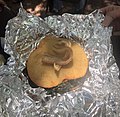Cornbread

| |
| A traditional slice of cornbread | |
| Alternative names | |
| Type | |
| Course | Side dish |
| Place of origin | Various |
| Region or state | |
| Associated national cuisine | |
| Created by | |
| Invented | |
| Cooking time | minutes to minutes |
| Serving temperature | Warm or room temperature |
| Main ingredients | Cornmeal, water, salt |
| Ingredients generally used | |
| Variations | Johnnycake, Hushpuppy, Corn pone |
| Food energy | kcal |
| Nutritional value | Protein: g, Fat: g, Carbohydrate: g |
| Glycemic index | |
| Similar dishes | |
| Other information | |
| Website | [ Official website] |
Cornbread is a type of bread made primarily with cornmeal and is a traditional staple food in various cuisines, particularly in the United States and parts of Africa. It can be baked, fried, or steamed, and its texture and ingredients can vary widely depending on the region and recipe.
History[edit]
The history of cornbread is closely tied to the history of corn (maize), which has been a fundamental food crop in the Americas for thousands of years. Native Americans were the first to cultivate corn and developed the first cornbread recipes, which were later adopted and adapted by European settlers in the Americas.
Ingredients and Preparation[edit]
The basic ingredients for cornbread include cornmeal, water, and salt. However, many variations exist, with recipes often including milk or buttermilk, eggs, baking powder, and sugar. Some versions also incorporate cheese, chilies, or fresh corn kernels for added flavor and texture.
Variations[edit]
- Southern cornbread is typically made with white cornmeal and has a less sweet, more crumbly texture.
- Northern cornbread often includes a higher proportion of wheat flour and sugar, resulting in a sweeter and more cake-like texture.
- Johnnycake is a cornbread that is cooked on a griddle or in a skillet.
- Corn pone is a type of cornbread made without milk or eggs, traditionally baked or fried in a skillet.
- Hushpuppy is a small, deep-fried ball made from cornmeal batter, often served as a side dish.
Cultural Significance[edit]
Cornbread holds significant cultural importance in many regions, particularly in the Southern United States, where it is often associated with traditional Southern cuisine and hospitality. It is also a common feature in soul food menus and has been celebrated in songs, literature, and folklore.
Serving[edit]
Cornbread can be served as a side dish or as a main component of a meal. It is often accompanied by beans, greens, chili, or barbecue. It can also be crumbled and used as a topping for dishes like casseroles or served with honey or syrup as a dessert.
See Also[edit]
Cornbread[edit]
-
Skillet cornbread
-
Dunkin' Donuts corn muffin
-
Blue cornbread
-
Yellow cornbread
-
Jonnycakes
-
Fried cornbread
Ad. Transform your life with W8MD's Budget GLP-1 injections from $75


W8MD offers a medical weight loss program to lose weight in Philadelphia. Our physician-supervised medical weight loss provides:
- Weight loss injections in NYC (generic and brand names):
- Zepbound / Mounjaro, Wegovy / Ozempic, Saxenda
- Most insurances accepted or discounted self-pay rates. We will obtain insurance prior authorizations if needed.
- Generic GLP1 weight loss injections from $75 for the starting dose.
- Also offer prescription weight loss medications including Phentermine, Qsymia, Diethylpropion, Contrave etc.
NYC weight loss doctor appointmentsNYC weight loss doctor appointments
Start your NYC weight loss journey today at our NYC medical weight loss and Philadelphia medical weight loss clinics.
- Call 718-946-5500 to lose weight in NYC or for medical weight loss in Philadelphia 215-676-2334.
- Tags:NYC medical weight loss, Philadelphia lose weight Zepbound NYC, Budget GLP1 weight loss injections, Wegovy Philadelphia, Wegovy NYC, Philadelphia medical weight loss, Brookly weight loss and Wegovy NYC
|
WikiMD's Wellness Encyclopedia |
| Let Food Be Thy Medicine Medicine Thy Food - Hippocrates |
Medical Disclaimer: WikiMD is not a substitute for professional medical advice. The information on WikiMD is provided as an information resource only, may be incorrect, outdated or misleading, and is not to be used or relied on for any diagnostic or treatment purposes. Please consult your health care provider before making any healthcare decisions or for guidance about a specific medical condition. WikiMD expressly disclaims responsibility, and shall have no liability, for any damages, loss, injury, or liability whatsoever suffered as a result of your reliance on the information contained in this site. By visiting this site you agree to the foregoing terms and conditions, which may from time to time be changed or supplemented by WikiMD. If you do not agree to the foregoing terms and conditions, you should not enter or use this site. See full disclaimer.
Credits:Most images are courtesy of Wikimedia commons, and templates, categories Wikipedia, licensed under CC BY SA or similar.
Translate this page: - East Asian
中文,
日本,
한국어,
South Asian
हिन्दी,
தமிழ்,
తెలుగు,
Urdu,
ಕನ್ನಡ,
Southeast Asian
Indonesian,
Vietnamese,
Thai,
မြန်မာဘာသာ,
বাংলা
European
español,
Deutsch,
français,
Greek,
português do Brasil,
polski,
română,
русский,
Nederlands,
norsk,
svenska,
suomi,
Italian
Middle Eastern & African
عربى,
Turkish,
Persian,
Hebrew,
Afrikaans,
isiZulu,
Kiswahili,
Other
Bulgarian,
Hungarian,
Czech,
Swedish,
മലയാളം,
मराठी,
ਪੰਜਾਬੀ,
ગુજરાતી,
Portuguese,
Ukrainian






